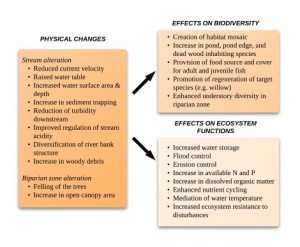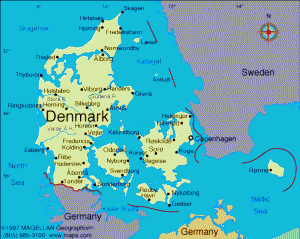In Christian Gamborg and Peter Sandøe’s journal article, “Beavers and biodiversity: the ethics of ecological restoration,” examines the different values behind ecological restoration projects with a focus in species introductions. The authors use a case study to compare the different ethical viewpoints. Some see ecological restoration as a process capable of reversing the loss of biodiversity. Anthropogenic activities such as hunting and farming as well as man-made structures, like roads and bridges, have slowly eradicated some species. Some believe restoring these areas through ecological restoration using practices like species reintroduction is an equally important conservation tool as wilderness preservation.
The goal of this type of restoration is to try to turn back the environmental clock and to return an area to a pre-disturbed state. The disagreements surrounding species reintroduction are caused by conflict of interests and disagreement of conflicting values. Reintroduction is “… attempt to establish a species in an area which was once part of its historical range, but from which it has been extirpated or extinct” (IUCN, 1995). Some describe areas that have been restored through reintroductions as “fakes” and that a place modified by human activity is not natural because it has not evolved out of natural processes.
The act of restoring or repairing an ecosystem has anthropogenic roots revolving around a fondness for technical fixes. It perpetuates the problem of human domination over nature. Others rebut this idea and say the act of returning nature to a pre-disturbed state is healing the relationship between people and nature, and our role as humans is both to preserve and restore nature, as well as use nature for our benefit.
Gamborg and Sandøe explain three main theories to describe peoples’ attitudes to species reintroductions. The first is a wide-use theory, which is a Pinochotian view of land use. People in this category see introductions and reintroductions as completely ethical it benefits humans and if the perceived benefits have been evaluated and balanced against the predictable negative consequences. The other extreme is a respect for nature view. They see human interference as domination and meddling with nature is seen as unethical. The middle view is the pragmatic view. This view disagrees with introductions, but sees reintroduction as ethical as long as environmental impact assessment or something similar has been performed.
The case study investigated in this journal article looks at the idea of beaver reintroduction in Europe. Beavers have been extirpated from the area for 2,000 years due to cattle husbandry. By the beginning of the 20th century there were only five small populations with 700 individual beavers in all of Europe. The recent project to reintroduce this keystone species has taken into account different interest groups who see themselves as stakeholders in the issue in Denmark where the reintroductions may happen. These groups include the Danish Ministry of Environment and Energy, the National Forest and Nature Agency, and landowners and farmers who will be directly affected by the reintroduction.
The Danish Ministry of Environment and Energy feels there is an international legal responsibility to reintroduce the beaver because the beaver is unlikely to be able to migrate to this part of its former, natural range due to fragmentation. They also see the ecological benefits of bringing back a keystone species to the ecosystem. The National Forest and Nature Agency claims they support the reintroduction for moral reasons. They say the beaver has a “right” to live there, in its natural habitat. They also support reintroduction for ecological variation and stability provided by this keystone species. Groups against the introduction, like hunters and farmers, fear the environmental impacts of beavers. Some independent government advisory councils argue that this reintroduction breaks the natural continuity and natural history of the areas where the reintroductions may take place. Farmers and landowners fear damage to trees, flooding, and wrecked fields on their properties. Some claim that we are trying to meddle with nature takes away the naturalness of an area, but the National Forest and Nature Agency counters that it is unnatural that beavers are not found in the wild in Scandinavia.
Finding compromises around nature management is a very difficult discussion because of the wide range of views and values surrounding land use. Although it is important to hear everyone who sees themselves as a stakeholder, ultimately the decision comes down to making the best decision for the most people and for the environment. The beaver, because it is a keystone species, is an important part of an ecosystem. Also, although the ecosystems have changed, they have only changed with the absence of the beaver because of human forces, so when trying to reintroduce them, the issue of humans meddling in nature should not be that big of an issue because it was human meddling that drove beavers away. As long all of the impacts are taken into account and recognized, both on the environment and on humans, beaver reintroductions would be beneficial to recreate a lost landscape.
Sources:
Gamborg, C. & Sandøe, P. (2004). Beavers and biodiversity: the ethics of ecological restoration. Philosophy and Biodiversity. 217–236. Cambridge: Cambridge University Press.
IUCN. (1995). IUCN Guidelines for Re-introductions. Gland: IUCN.
MP



